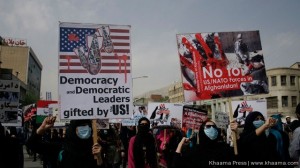Described Focus of Protest in Kabul Dependent on News Outlet
The Wall Street Journal ran with the headline “Islamic State’s Siege of Kobani, Syria Sparks Protest in Kabul, Afghanistan” while Iran’s PressTV went with “Afghan protesters blast US-led forces, BSA”. Remarkably, Afghanistan’s Khaama Press did not see it necessary to spin the focus of the protest in a particular direction, using the headline “Afghans protest against Islamic State, US and NATO forces in Kabul”.
The Khaama Press article quickly sums up the protest:
Over 500 people participated in a demonstration against the Islamic State and presence of US and NATO forces in Afghanistan.
The protesters were shouting slogans against the presence of US and NATO forces in Afghanistan and in support of the Kurdish people who are fighting the Islamic State militants.
Protesters were also carrying signs purporting crimes committed by US and NATO forces in Afghanistan and resistance of the female Kurdish fighters against the Islamic State.
The US and NATO were also accused by protester for supporting the extremist groups in Afghanistan and Kobane.
We learn in the article that the protest was organized by the Solidarity party of Afghanistan, which Khaama described as “a small and left wing political party in the country”. Presumably, since they were allowed to stage the protest, the ban on the party issued in 2012 must have been lifted.
One has to read the Wall Street Journal article very carefully to find any evidence of the US criticism that was in the protest. The article opens:
Residents of Kabul have a war on their own doorstep: The provinces around the Afghan capital have seen an upsurge in violence this year.
But the conflict in Syria was on the minds of demonstrators who marched Sunday in solidarity with the town of Kobani, Syria, currently under siege by Islamic State militants.
Over a hundred Afghans—most of them women—held placards supporting Kurdish fighters defending the city.
Near the end, the article mentions, but dismisses as “conspiracy theory”, the accusations of US involvement in the creation of ISIS:
Conspiracy theories often thrive in Afghanistan, and at Sunday’s protest, many demonstrators expressed the belief that Islamic State was a U.S. creation. Some held placards saying, “Yankee Go Home.”
The article then mentions the BSA without stating that it was also a target of the protest other than citing the “Yankee Go Home” sign.
PressTV, on the other hand, focused exclusively on the anti-US aspects of the protest. In fact, the video accompanying their story does not match the photo that is used in the video frame while the video isn’t playing. The photo, which is full-frame, shows protesters somewhere burning an American flag, but the video itself-which appears to match the same event in the Khaama Press photo-only partially fills the frame and does not show any flag-burning. PressTV opens:
Afghan protesters have staged a rally in the streets of the nation’s capital, Kabul, to reiterate their opposition to the continued presence of US-led troops in the war-ravaged country.
Hundreds of demonstrators marched through the capital on Sunday to also express their outrage against the so-called Bilateral Security Agreement (BSA) signed by the newly-inaugurated President Ashraf Ghani Ahmadzai.
The protesters were reportedly carrying banners pointing to alleged crimes committed by US and NATO forces across Afghanistan
Remarkably, even though Iran is staunchly opposed to ISIS, the PressTV story makes no mention of the protest also being aimed against ISIS, or even of the accusations of a US role in the creation of ISIS.
Congratulations to Khaama Press for choosing to not spin a story that major outlets in the US and Iran used as propaganda pieces.

